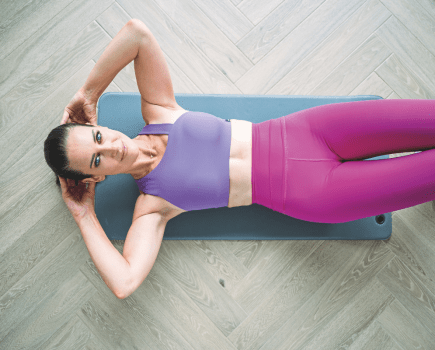Breathing is so automatic that you tend not to think about how it affects your body. But read on to discover how breathing better could be the key to transforming your life.
By Helen Foster
You take around 20,000 breaths a day. Considering how vital it is, it’s a simple process. Breathing in makes your diaphragm tighten and move down, making space for your lungs to take in air. Oxygen from this air passes through your lungs into your blood vessels to circulate through your body. At the same time, carbon dioxide moves from the bloodstream into your lungs. On your exhale, the diaphragm goes back upwards, pushing that carbon dioxide out and into the air.
Ideally you should fill your lungs with as much air as you can – that’s 3-4 litres! – pulling the air down deep into your lungs. Then, you should exhale fully so the used up gases leave your lungs, creating maximum room for another oxygen-filled breath.
The problem is, many of us aren’t doing this effectively. Most of us breathe in only around 500ml of air per breath. ‘About 90-95 per cent of people don’t use their lower muscles to breathe, instead only using the secondary muscles in the upper part of the chest that should normally only kick in when you need to breathe quickly,’ explains breath expert Richie Bostock, aka The Breath Guy. And, chances are you rarely exhale fully so you never completely exchange all the used gas for fresh new air that powers your body. ‘What people don’t realise is that correct breathing is the most underrated way to shift the way you think and feel,’ says Richie. ‘When you breathe effectively, you create changes in your nervous system and an exchange of gases in your blood that can directly alter your body both physically and mentally.’

Breathing well improves physical and mental health
Breathing better for a physical boost
How exactly can breathing well benefit you? Let’s start with the physical changes. ‘The movement of your diaphragm acts as an internal massage to your body’s organs – this helps stimulate the natural removal of toxic by-products,’ says Claire Dale, co-author of Physical Intelligence (£14.99, Simon and Schuster). On top of this, breathing well has been proven to positively affect immunity. In fact, at least two studies have shown that slow, controlled breathing directly triggers a release of anti-inflammatory compounds by your immune system.
Breathing efficiently also floods your body with the oxygen it needs to thrive, while preventing a build-up of carbon dioxide that can leave you sluggish. ‘If you want to energise your system, one of the easiest ways to do it is with the breath,’ says Claire. ‘Correct breathing can also improve how you think. Teaching people to breath in a steady manner actually led to a 62 per cent increase in cognitive capacity and complex reasoning in one South African study.’
Not only is increased oxygen likely to be part of the reason for this, but effective breathing actually changed the patterns of brain waves, producing fewer waves that led to scattered thinking and more waves that led to focus.
Good breathing also calms your body. When you’re stressed you hold your breath and breathe in a shallow manner. ‘This leads to a build-up of carbon dioxide, which then raises cortisol levels, increasing your anxiety,’ says Claire. ‘Slowing and deepening your breathing is therefore one of the easiest and quickest ways to reduce stress.’ It also has a knock on effect of lowering blood pressure.
The mental benefits of breathing well
But good breathing doesn’t just lead to physical changes. Every emotion has a precise breathing pattern. ‘When we’re angry, we huff and puff; when we sob we expel air in tiny bursts then take a huge gulp of air inwards; laughter is just quick, rapid breathing,’ says Richie. The link between breath pattern and emotional state is so strong that in one study at Belgium’s University of Louvain, people asked to breathe in a ‘happy’ or ‘angry’ way ended up feeling that way simply because they’d changed their breath pattern.
The direct ability for your breath to change how you feel has led to the development of breathwork – techniques where the breath pattern is manipulated to help change emotional states. ‘You can use the breath to generate feelings you may have supressed and then release them. This can literally change people’s lives,’ says Richie.
It’s often the way that the most seemingly simple things, such as breathing, can have the most profound impact. But to see benefits you have to remember to make changes and do it consistently. By making a more conscious effect to tune in to how you are breathing – perhaps by setting an alarm on your phone every hour or half hour – you could begin to transform the way you feel in both body and mind, and it won’t cost you a penny.

Practise slower, deeper breathing
Observing the way you breathe
There are two types of breathing that influence the state of your body: conscious and unconscious. Unconscious is the kind you do without thinking about it and which keeps you alive, while conscious is where you actively use your breath to create a direct result, such as raising energy. With both, the same basic elements come into play: speed, depth, whether you breathe via your mouth or nose, and the ratio of time spent inhaling to exhaling. Consider these…
Speed: ‘The speed at which you breathe directly influences your nervous system,’ says Claire. ’Slowing your breathing will calm you down. If you wish to energise yourself, you can breathe a little faster.’ Normal breathing has a pace of about 12-14 breaths per minute; to calm your body drop, that to 5-7 per minute; to energise, speed it up to 15-16.
Depth: This is the most important part of good breathwork and the thing most of us don’t do effectively. ‘You need to breathe deep into your lungs so your diaphragm moves up and down,’ explains Claire. Try to expand your belly and ribs as you inhale, and press them back in as you exhale.
Mouth or nose: ‘Mouth breathers get a bad rap,’ says Claire. ‘Inhaling through the mouth is the best way to get a lot of air into your lungs quickly.’ However, it’s still better to inhale through your nose most of the time – not only has it been shown to stimulate the parasympathetic system to calm you down, it also warms the air and filters out some pollutants and germs.
In/out ratio: For normal breathing, your exhale should be slightly longer than your inhale. A count of four seconds in and seven out is ideal.
How well do you breathe?
We asked Richie Bostock to come up with a short test that can reveal whether you’re breathing well. Here’s what he suggests:
- Take a deep breath in and out just to get used to the feeling.
- Now, inhale just as you would normally but this time pay attention to what is happening to your shoulders. Do they go up or down? If they go up, this indicates you’re breathing with your secondary muscles rather than your diaphragm.
- Next, sit or lie down with one hand on your chest and one hand on your stomach. Again, take a deep breath in just as you would normally do – which hand moves outwards? If it’s your stomach, that’s good, you’re breathing from the diaphragm. If it’s your chest, that’s another sign that you’re just using your upper muscles and therefore not inhaling as deeply as you could be.
Further reading and references:
- How many breaths you take each day
- How your lungs work:
- How breathing improves your immunity
- How breathing affects your mood
- Study on alternate nostril breathing
- Lack of sleep leads to poorer breathing
Helen Foster is a health journalist and author of several health books, as well as the blog Not Your Normal Health Blog








